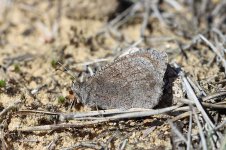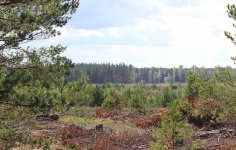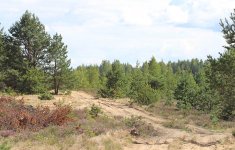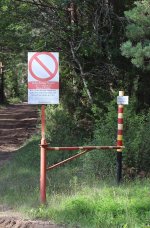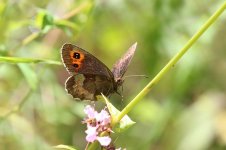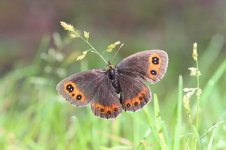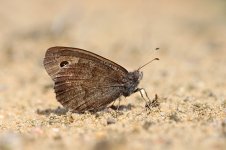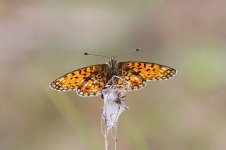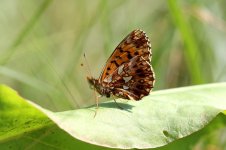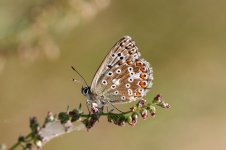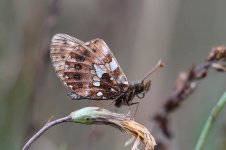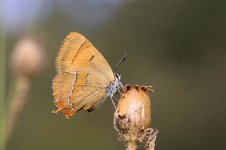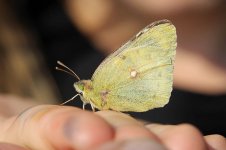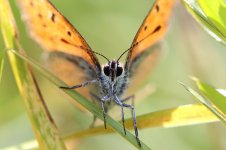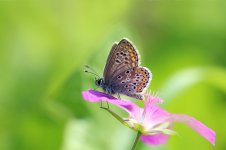
-
Welcome to BirdForum, the internet's largest birding community with thousands of members from all over the world. The forums are dedicated to wild birds, birding, binoculars and equipment and all that goes with it.
Please register for an account to take part in the discussions in the forum, post your pictures in the gallery and more.
You are using an out of date browser. It may not display this or other websites correctly.
You should upgrade or use an alternative browser.
You should upgrade or use an alternative browser.
Baltic Butterfly Challenge, 2016 (1 Viewer)
- Thread starter Jos Stratford
- Start date
More options
Who Replied?Andy Adcock
Worst person on Birdforum

A lot more tolerant than the Russians, I got detained by armed security on a public footpath near a Gazprom terminal. I would not venture near a miltary zone with bins and camera!
A
A

14 August. Scotch Argus Tumbles in Latvian Backwoods.
Third excursion of the year into Latvia, target Scotch Argus, a species not seen in Lithuania for several decades, but still very common in the open pine forests south-west of Riga. Forecasts of very mixed weather did not bode particularly well, but with sunny spells at least theoretical, I set off from Vilnius at 6.00 a.m. for the three-and-a-half hour drive.
Overcast and dull on arrival! Remarkably however, even before parking the car, I spied a dark butterfly fluttering weakly across the rosdside verge. Scotch Argus! Parked and wandered for a while, soon found more ...five Scotch Argus, mostly settled on the ground or low vegetation. Then, a bare ten minutes after arriving, it began to rain, butterflies vanished, game over for a while.
Fortunately, just over an hour later, broad pockets of blue sky appeared, resultant sunny spells lasting through to afternoon...and with the better weather, numerous more Scotch Argus, perhaps 60 or more, plus a small assortment of other species, one Camberwell Beauty and several tatty Silver-studded Blues amongst them.
Banks of cloud then rolled in, I departed and began the return journey. A few kilometers further however, blue skies returned, so I stopped at a random patch of forest, exploring broad tracks and seas of clear fell. A good decision - two dozen species seen, a very fine late summer collection, including Weaver’s Fritillary, Queen of Spain Fritillary, Large Grizzled Skipper, Pale Clouded Yellow and a motley crew of faded left overs from earlier in the season, Scarce Coppers, Small Pearl-bordered Fritillaries and the like.
So there we have it, a day in Latvia, 28 species seen, critically including Scotch Argus, my 107th species of the year in the Baltic States.
BALTIC YEAR LIST
107. Scotch Argus (102 for Lithuania)
Third excursion of the year into Latvia, target Scotch Argus, a species not seen in Lithuania for several decades, but still very common in the open pine forests south-west of Riga. Forecasts of very mixed weather did not bode particularly well, but with sunny spells at least theoretical, I set off from Vilnius at 6.00 a.m. for the three-and-a-half hour drive.
Overcast and dull on arrival! Remarkably however, even before parking the car, I spied a dark butterfly fluttering weakly across the rosdside verge. Scotch Argus! Parked and wandered for a while, soon found more ...five Scotch Argus, mostly settled on the ground or low vegetation. Then, a bare ten minutes after arriving, it began to rain, butterflies vanished, game over for a while.
Fortunately, just over an hour later, broad pockets of blue sky appeared, resultant sunny spells lasting through to afternoon...and with the better weather, numerous more Scotch Argus, perhaps 60 or more, plus a small assortment of other species, one Camberwell Beauty and several tatty Silver-studded Blues amongst them.
Banks of cloud then rolled in, I departed and began the return journey. A few kilometers further however, blue skies returned, so I stopped at a random patch of forest, exploring broad tracks and seas of clear fell. A good decision - two dozen species seen, a very fine late summer collection, including Weaver’s Fritillary, Queen of Spain Fritillary, Large Grizzled Skipper, Pale Clouded Yellow and a motley crew of faded left overs from earlier in the season, Scarce Coppers, Small Pearl-bordered Fritillaries and the like.
So there we have it, a day in Latvia, 28 species seen, critically including Scotch Argus, my 107th species of the year in the Baltic States.
BALTIC YEAR LIST
107. Scotch Argus (102 for Lithuania)


15-17 August. Season’s Decline.
One day of reasonable sun, two days of cool, wet and blustery conditions. Even on the sunny day, a marked decline in butterfly numbers - visiting Labanoras and Kernave, I notched up 21 species, top of the pick being my second Brown Argus of the year, with other nice butterflies including Little Blue and three Queen of Spain Fritillaries.
These aside though, numbers of most species were well down, the key exceptions being Red Admirals and Small Tortoiseshells, both of which were more abundant than in recent weeks, perhaps the start of a final flush. All in all however, especially with the onset of heavy rain, the season truly felt near its end.
18-21 August. Grand Finale.
Scraping the barrel, there were only a couple of final potential species remotely possible this year ...Brown Hairstreak was the most likely, a butterfly that I had not seen in Lithuania since 2009, and after that a vagrant species from south, one of the clouded yellow group being at the top of my mind, even though none are annual in Lithuania! And so I turned my attentions to these butterflies!
18 August. Dukstos.
Despite searching for Brown Hairstreak without success in several localities over the previous couple of weeks, I reasoned I had as good a chance in the Neris Valley as anywhere else, so decided upon the mixed forest and meadow landscapes of the Dukstos area this day. Hit and miss weather, good sunny periods and about 20 C, but so too occasional banks of clouds and spots of rain.
Further reductions in butterfly numbers immediately apparent, only 13 species seen with Common Blues and Small Heaths the only species appearing in fairly good numbers. As for Brown Hairstreak, I searched high and low in areas that I thought looked encouraging, but saw zilch. Then however, as I tramped back towards my car after three hours of wandering, there was a Brown Hairstreak! Surely the most stunning of the Lithuanian hairstreaks, the vivid oranges of this fresh individual were simply splendid. Probably the last new species for the year, a wonderful finale to an excellent year.
Stupid me, I forgot to put a memory card in the camera, so no shots this day - fortunately I have a photograph of a near identical of this stunner from 2009 (below).
BALTIC YEAR LIST
108. Brown Hairstreak (103 for Lithuania)
21 August. Druskininkai.
Southern border areas again. Basic reason to be in this region was to search for potential vagrants from more southerly parts of Europe, for example Clouded Yellow, Berger's Clouded Yellow or, probably unlikely these days, Danube Clouded Yellow.
With temperatures topping 26 C, a fine day it turned out, 28 species seen in all, with exceptional numbers of some late butterflies - my highest ever single day count, I estimated a minimum of 460 Red Admirals were present, quite possibly quite an under-estimate. Alongside, also at least 80 Queen of Spain Fritillaries, another personal record for a day count. And much more too - ten Weaver's Fritillaries, five Small Pearl-bordered Fritillaries, five tatty Silver-spotted Skippers, a couple of small colonies of Reverdin's Blues and, wonderfully fresh individuals, seven Chalkhill Blues.
Checked two main localities along the border, numerous butterflies at both, but numbers of migrant butterflies were decidedly low - a mere seven Painted Ladies and six Pale Clouded Yellows. However, late afternoon, I hit the jackpot - the deep yellows of a Clouded Yellow catching my eye. Typical of the species, it was highly mobile, flying at speed across the territory, appearing to have actually flown in from Belarus. Went racing after it, had it settle for a brief second, before it stormed off north, eventually rising over a line of trees to vanish into Lithuania's interior! Clicked my camera wildly at the rapidly disappearing butterfly, a vivid yellow blurry blob the result.
BALTIC YEAR LIST
109. Clouded Yellow (104 for Lithuania)
22 August. Pabrade.
Labanoras fairly quiet, so decided to cut back to the military areas near Pabrade. Rat-a-tat of automatic gunfire at the first block, but fortunately all clear at my favoured site some 3 km further. Camberwell Beauty to welcome me, then a steady procession of Red Admirals and occasional Painted Ladies as I walked the kilometre or so to the central open areas.
26 C again, bright sun, I had high hopes of further Tree Graylings on the heath. And I was not disappointed - a little beyond where I encountered them the previous week, I found no less than four this time. Slightly faded, especially the creamy rings, but nice all the same. Also, remnants of flights earlier in the season, a couple of Rock Graylings in the same area, a dozen Silver-studded Blues too. Wandering back to the car, added single Wall Browns and Speckled Woods, quite probably my last of the year in Lithuania.
One day of reasonable sun, two days of cool, wet and blustery conditions. Even on the sunny day, a marked decline in butterfly numbers - visiting Labanoras and Kernave, I notched up 21 species, top of the pick being my second Brown Argus of the year, with other nice butterflies including Little Blue and three Queen of Spain Fritillaries.
These aside though, numbers of most species were well down, the key exceptions being Red Admirals and Small Tortoiseshells, both of which were more abundant than in recent weeks, perhaps the start of a final flush. All in all however, especially with the onset of heavy rain, the season truly felt near its end.
18-21 August. Grand Finale.
Scraping the barrel, there were only a couple of final potential species remotely possible this year ...Brown Hairstreak was the most likely, a butterfly that I had not seen in Lithuania since 2009, and after that a vagrant species from south, one of the clouded yellow group being at the top of my mind, even though none are annual in Lithuania! And so I turned my attentions to these butterflies!
18 August. Dukstos.
Despite searching for Brown Hairstreak without success in several localities over the previous couple of weeks, I reasoned I had as good a chance in the Neris Valley as anywhere else, so decided upon the mixed forest and meadow landscapes of the Dukstos area this day. Hit and miss weather, good sunny periods and about 20 C, but so too occasional banks of clouds and spots of rain.
Further reductions in butterfly numbers immediately apparent, only 13 species seen with Common Blues and Small Heaths the only species appearing in fairly good numbers. As for Brown Hairstreak, I searched high and low in areas that I thought looked encouraging, but saw zilch. Then however, as I tramped back towards my car after three hours of wandering, there was a Brown Hairstreak! Surely the most stunning of the Lithuanian hairstreaks, the vivid oranges of this fresh individual were simply splendid. Probably the last new species for the year, a wonderful finale to an excellent year.
Stupid me, I forgot to put a memory card in the camera, so no shots this day - fortunately I have a photograph of a near identical of this stunner from 2009 (below).
BALTIC YEAR LIST
108. Brown Hairstreak (103 for Lithuania)
21 August. Druskininkai.
Southern border areas again. Basic reason to be in this region was to search for potential vagrants from more southerly parts of Europe, for example Clouded Yellow, Berger's Clouded Yellow or, probably unlikely these days, Danube Clouded Yellow.
With temperatures topping 26 C, a fine day it turned out, 28 species seen in all, with exceptional numbers of some late butterflies - my highest ever single day count, I estimated a minimum of 460 Red Admirals were present, quite possibly quite an under-estimate. Alongside, also at least 80 Queen of Spain Fritillaries, another personal record for a day count. And much more too - ten Weaver's Fritillaries, five Small Pearl-bordered Fritillaries, five tatty Silver-spotted Skippers, a couple of small colonies of Reverdin's Blues and, wonderfully fresh individuals, seven Chalkhill Blues.
Checked two main localities along the border, numerous butterflies at both, but numbers of migrant butterflies were decidedly low - a mere seven Painted Ladies and six Pale Clouded Yellows. However, late afternoon, I hit the jackpot - the deep yellows of a Clouded Yellow catching my eye. Typical of the species, it was highly mobile, flying at speed across the territory, appearing to have actually flown in from Belarus. Went racing after it, had it settle for a brief second, before it stormed off north, eventually rising over a line of trees to vanish into Lithuania's interior! Clicked my camera wildly at the rapidly disappearing butterfly, a vivid yellow blurry blob the result.
BALTIC YEAR LIST
109. Clouded Yellow (104 for Lithuania)
22 August. Pabrade.
Labanoras fairly quiet, so decided to cut back to the military areas near Pabrade. Rat-a-tat of automatic gunfire at the first block, but fortunately all clear at my favoured site some 3 km further. Camberwell Beauty to welcome me, then a steady procession of Red Admirals and occasional Painted Ladies as I walked the kilometre or so to the central open areas.
26 C again, bright sun, I had high hopes of further Tree Graylings on the heath. And I was not disappointed - a little beyond where I encountered them the previous week, I found no less than four this time. Slightly faded, especially the creamy rings, but nice all the same. Also, remnants of flights earlier in the season, a couple of Rock Graylings in the same area, a dozen Silver-studded Blues too. Wandering back to the car, added single Wall Browns and Speckled Woods, quite probably my last of the year in Lithuania.

Selection of the latest butterflies:
- Tree Grayling
- Small Pearl-bordered Fritillary
- Weaver's Fritillary
- Chalkhill Blue
- Tree Grayling
- Small Pearl-bordered Fritillary
- Weaver's Fritillary
- Chalkhill Blue
Attachments
StuartReeves
Local rarity
Fantastic score Jos. Is that it for the year or do you have any more long-shots at the back of your mind?

Fantastic score Jos. Is that it for the year or do you have any more long-shots at the back of your mind?
Highly unlikely for any further additions - a (very) remote chance remains of one of the rarer clouded yellows ...but this would also assume I could identify them in the field even if they were to occur. That said, I will be searching the southern borders again in the coming days ...
One retrospective addition possible ...back in July, I tried separating Cryptic Wood White in the field and found one in particular that I think looks very prospective. Photographed it, along with every other wood white that I saw in the season ...now about to start analyzing the pictures to see if I can confirm the identity.
Otherwise, will still be actively plotting the final ups and downs of the season till the first frosts finish everything off.
Last edited:
StuartReeves
Local rarity
Good luck with decrypting the Wood Whites! Did you miss any species? I'm wondering how close you'll be to a clean sweep of every species known to have occurred in Lithuania/the three Baltic States during 2016.

Good luck with decrypting the Wood Whites! Did you miss any species? I'm wondering how close you'll be to a clean sweep of every species known to have occurred in Lithuania/the three Baltic States during 2016.
Lithuanian list is 126 species, including Cyptic Wood White and the eight below. Of the others, they are basically species which have occurred once or twice or not seen for several decades.
Species which I missed:
a. species I sometimes see:
Black Hairstreak (saw annually 2009-2011, not since)
Chequered Skipper (last saw in 2008)
b. other species I tried for:
Olive Skipper
Safflower Skipper
Tufted Marbled Skipper
c. other possibles which I didn't look for:
Green-underside Blue
Dingy Skipper
Scarce Fritillary

Way back at the end of August I had assumed that my butterfly season in the Baltic States was nearing its end ...how wrong I was! Usually butterflies are over and done by September, but this year the month was simply excellent, with numerous species enjoying the above average temperatures and even a number of species managing an extra generation.
1-3 September. Autumn Pickings.
The first three days of September were grand, a haul of no less than 22 species still on the wing, some in good numbers. Two areas visited - meadows south of the capital and borderlands in the far south, both proving better than expected. At the first locality, forest tracks were almost devoid of butterflies, but arriving a favourite area of meadow adjacent, the sight was awesome - in temperatures above 25 C, a multitude of whites and others fluttering across the fields.
Exploring in depth, the rewards were plenty - in addition to the several hundred Small Whites and Green-veined Whites, also a mighty impressive 80 Weaver's Fritillaries and minimum of 30 Queen of Spain Fritillaries, high totals indeed, especially for so late in the season. Also here, amongst the total of 16 species, at least 15 Pale Clouded Yellows and three Eastern Bath Whites.
A couple of days later, though the sun had been replaced by high cloud, the species tallies soared ever higher. Visiting my regular localities in the Belarussian border zone near Druskininkai, my expectations had been rather low due to the cloud, but fortunately it gradually became brighter and warmer as the day wore on ...and with the improvement, slowly, slowly, more and more butterflies! Saw 20 species in all, including typical early autumn species such as Red Admiral, Comma and Small Tortoiseshell, plus lingering (and mostly tatty) butterflies from earlier in the season, amongst them Scarce, Sooty and Small Coppers and High Brown Fritillary. Best of the bunch however were Large Grizzled Skipper, Chalkhill Blue, Map Butterfly and Reverdin's Blue (all two-three weeks since my previous sightings).
7-11 September. Yet More.
One day of wet weather on the 4th, then back to days of splendid sunshine and temperatures approaching 25 C ...some of the best weather of the year! I had expected the year to have been largely over by now in terms of butterflies, but how pleasantly wrong I was!!! With trips to meadows south of Vilnius, to Labanoras and to the Kernave and Dukstos areas, I was still managing to record up to 16 or 17 species a day, rather impressive I think for September in the Baltic States. And better still, amongst the rich selection, I was also seeing some very nice numbers and species. Of the high tallys, the most significant included around 65 Pale Clouded Yellows, a mighty 55 Queen of Spain Fritillaries and a wonderful 25 Eastern Bath Whites (my highest day total of the year, representing more in the single day than I often see in an average year).
Notable species included a vagrant Clouded Yellow on the 9th, two Brown Hairstreaks on the 11th and five Brown Argus on the 11th. Though an non-annual visitor to Lithuania, the Clouded Yellow was my second of the year, while the Brown Hairstreaks were my second and third and the Brown Argus my third to eighth of the year! I hadn't expected any of these species to still be flying!
Also found two more late Large Grizzled Skippers (7th and 11th), an equally late Map Butterfly (11th), a Speckled Wood (10th) and no less than 19 Small Coppers (9th and 11th). With the forecast set to remain good for at least another week, all was looking excellent for continued butterfly action for some time yet!
15-18 September. The Final Countdown.
It was always a question how long the amazing run of high temperatures could last. Well, the forecasts now predicted pitiful temperatures of just 12-13 C for the next week, with rain fairly frequent. That should just about end the butterfly season! In the meantime however, it was excellent - no less than 16 species recorded on the 15th and, despite a notable chill to the air and mostly overcast skies, still 10 species on the 18th. Highlights? All scattered between sites in the Druskinikai area and meadows south of Vilnius, another 20 or so Pale Clouded Yellows, no less than 74 Queen of Spain Fritillaries (!) and 32 Small Coppers, along with a single Eastern Bath White, a late Chalkhill Blue and an equally late Reverdin's Blue.
Also saw Sooty Copper, Scarce Copper, Weaver's Fritillary and Speckled Wood.
25-26 September. On it Ticks!
No end to the season - after a run of cloudy days hovering around 12 C with periodic rain, a return to partial sun and 14 C revealed it was not all over! Far from it, no less than ten species still on the wing in my favoured meadows on the 25th, some in very good numbers. Queen of Spain Fritillaries totalled perhaps 40, some very fresh looking individuals, Small Coppers were sitting at a minimum of 35 and Pale Clouded Yellows at about 18.
Remarkably, an impressive 12 Eastern Bath Whites were also present, plus three Sooty Coppers, a dozen Small Whites, two Green-veined Whites, a Comma and a Weaver's Fritillary . Two other localities on the 26th produced yet more butterflies, albeit in lower numbers - eight Pale Clouded Yellows, one Queen of Spain Fritillary, three Small Whites, a Comma and, now very late, a lingering Scarce Copper.
These apparent abundances however are somewhat deceptive - most localities, especially non-meadow habitats, are now totally devoid of butterflies. That said, there must be odds on chances for a reasonable selection of butterflies lasting even until October this year!
1-3 September. Autumn Pickings.
The first three days of September were grand, a haul of no less than 22 species still on the wing, some in good numbers. Two areas visited - meadows south of the capital and borderlands in the far south, both proving better than expected. At the first locality, forest tracks were almost devoid of butterflies, but arriving a favourite area of meadow adjacent, the sight was awesome - in temperatures above 25 C, a multitude of whites and others fluttering across the fields.
Exploring in depth, the rewards were plenty - in addition to the several hundred Small Whites and Green-veined Whites, also a mighty impressive 80 Weaver's Fritillaries and minimum of 30 Queen of Spain Fritillaries, high totals indeed, especially for so late in the season. Also here, amongst the total of 16 species, at least 15 Pale Clouded Yellows and three Eastern Bath Whites.
A couple of days later, though the sun had been replaced by high cloud, the species tallies soared ever higher. Visiting my regular localities in the Belarussian border zone near Druskininkai, my expectations had been rather low due to the cloud, but fortunately it gradually became brighter and warmer as the day wore on ...and with the improvement, slowly, slowly, more and more butterflies! Saw 20 species in all, including typical early autumn species such as Red Admiral, Comma and Small Tortoiseshell, plus lingering (and mostly tatty) butterflies from earlier in the season, amongst them Scarce, Sooty and Small Coppers and High Brown Fritillary. Best of the bunch however were Large Grizzled Skipper, Chalkhill Blue, Map Butterfly and Reverdin's Blue (all two-three weeks since my previous sightings).
7-11 September. Yet More.
One day of wet weather on the 4th, then back to days of splendid sunshine and temperatures approaching 25 C ...some of the best weather of the year! I had expected the year to have been largely over by now in terms of butterflies, but how pleasantly wrong I was!!! With trips to meadows south of Vilnius, to Labanoras and to the Kernave and Dukstos areas, I was still managing to record up to 16 or 17 species a day, rather impressive I think for September in the Baltic States. And better still, amongst the rich selection, I was also seeing some very nice numbers and species. Of the high tallys, the most significant included around 65 Pale Clouded Yellows, a mighty 55 Queen of Spain Fritillaries and a wonderful 25 Eastern Bath Whites (my highest day total of the year, representing more in the single day than I often see in an average year).
Notable species included a vagrant Clouded Yellow on the 9th, two Brown Hairstreaks on the 11th and five Brown Argus on the 11th. Though an non-annual visitor to Lithuania, the Clouded Yellow was my second of the year, while the Brown Hairstreaks were my second and third and the Brown Argus my third to eighth of the year! I hadn't expected any of these species to still be flying!
Also found two more late Large Grizzled Skippers (7th and 11th), an equally late Map Butterfly (11th), a Speckled Wood (10th) and no less than 19 Small Coppers (9th and 11th). With the forecast set to remain good for at least another week, all was looking excellent for continued butterfly action for some time yet!
15-18 September. The Final Countdown.
It was always a question how long the amazing run of high temperatures could last. Well, the forecasts now predicted pitiful temperatures of just 12-13 C for the next week, with rain fairly frequent. That should just about end the butterfly season! In the meantime however, it was excellent - no less than 16 species recorded on the 15th and, despite a notable chill to the air and mostly overcast skies, still 10 species on the 18th. Highlights? All scattered between sites in the Druskinikai area and meadows south of Vilnius, another 20 or so Pale Clouded Yellows, no less than 74 Queen of Spain Fritillaries (!) and 32 Small Coppers, along with a single Eastern Bath White, a late Chalkhill Blue and an equally late Reverdin's Blue.
Also saw Sooty Copper, Scarce Copper, Weaver's Fritillary and Speckled Wood.
25-26 September. On it Ticks!
No end to the season - after a run of cloudy days hovering around 12 C with periodic rain, a return to partial sun and 14 C revealed it was not all over! Far from it, no less than ten species still on the wing in my favoured meadows on the 25th, some in very good numbers. Queen of Spain Fritillaries totalled perhaps 40, some very fresh looking individuals, Small Coppers were sitting at a minimum of 35 and Pale Clouded Yellows at about 18.
Remarkably, an impressive 12 Eastern Bath Whites were also present, plus three Sooty Coppers, a dozen Small Whites, two Green-veined Whites, a Comma and a Weaver's Fritillary . Two other localities on the 26th produced yet more butterflies, albeit in lower numbers - eight Pale Clouded Yellows, one Queen of Spain Fritillary, three Small Whites, a Comma and, now very late, a lingering Scarce Copper.
These apparent abundances however are somewhat deceptive - most localities, especially non-meadow habitats, are now totally devoid of butterflies. That said, there must be odds on chances for a reasonable selection of butterflies lasting even until October this year!


October, the Grand Finale of the Season, 2016.
Amazing weather to start the month - positively tropical at 20 C, the result being still numerous butterflies on the wing. Amongst 16 species, unprecedented records of Chestnut Heath and two Large Coppers, neither species ever recorded so late in the season in Lithuania.
1-2 October. The New Summer.
Always a potential for frost in the early days of October, even snow on a rare occasion. Not so this year however - the month beginning with sunshine and very unseasonal highs of 20 C. In these stunning conditions, numerous butterflies remained on the wing, numbers actually rising as new freshly-emerged individuals appeared, including ultra unusual records of both Chestnut Heath and Large Copper, both usually single-brooded summer butterflies in the Baltic States. This is the first record of a second generation Chestnut Heath in Lithuania, whilst only the second of Large Copper (one record existing of an individual on 17 September some years ago). Over and above these however, numbers of butterflies in general were impressive - in many a year, all butterflies have long disappeared by October, but in the sunshine at an assortment of productive meadows north and south of the capital, no less than 16 species and 250 individual butterflies were noted on the first day of the month, this actually representing a significant rise on the numbers in late September! Amongst them, quite a number of fresh newly-emerged individuals, especially Queen of Spain Fritillaries, Eastern Bath Whites, Small Whites and Small Coppers, active mating and egg laying observed. Lots of Pale Clouded Yellows too, plus a rise in Commas and a reappearance of Painted Ladies, Peacocks and Brimstones.
Somewhat a surprise, two Brown Argus were also seen, these also being the first October records for Lithuania. On the bird front, Cranes and Whooper Swans heading south. Little parties of Crossbills doing the same.
3 October. Last Gasp for last Large Copper.
With the forecasts for the following week looking ominous, this was likely to be my last real opportunity for any numbers of butterflies in 2016. Out I headed to meadows. Though mostly overcast and cool in the morning, with a grand total of just three butterflies seen (one Green-veined White and two Small Whites), things totally flipped to the positive in early afternoon when a weak sun broke though – as the temperature clambered up to 16 C, butterflies emerged for the final finale ...20 Queen of Spain Fritillaries, one Weaver's Fritillary, 16 Pale Clouded Yellows, five Eastern Bath Whites, all very nice. Also a couple of dozen Small Whites, eight Small Coppers and three Peacocks. The biggest surprise however was another Large Copper – initially assuming it was the same individual as seen a couple of days later, the underwing spotting identified it as a new individual, quite remarkable ...and signs that the species certainly had a second generation this year.
So, one brief sunny spell, nine species and approximately 75 individual butterflies ...the grand finale, over and out.
4-9 October. Season's End.
And then it was all over, the butterfly season coming to a grinding halt as autumn hit with a vengeance! Days and days of strong winds, heavy rain and daytime temperatures down to 5 C ...no point even looking for butterflies! No sun forecast for several more days to come, even then the temperatures not predicted to rise very much - I seriously doubt there will be an encore to follow!
13-16 October. No Encore.
Sunny days again, but hard frost and night temperatures hitting minus 3 C. One brave butterfly in the relative warmth of the late afternoon on the 13th (a Brimstone), but otherwise the meadows and woodland edges have fallen quiet, the butterfly season is truly over. Still, with a brief flurry of snow on the 14th, winter is not so far away ...time to resume my ringing at my winter feeding stations. Weekend one notched up a bunch of birds, a good number of both Marsh and Willow Tits amongst them. Also at my feeding station, a Hazel Grouse just nearby, Bewick's Swans overhead and a Wigeon on a pool. Goodbye butterflies, hello birds.
Amazing weather to start the month - positively tropical at 20 C, the result being still numerous butterflies on the wing. Amongst 16 species, unprecedented records of Chestnut Heath and two Large Coppers, neither species ever recorded so late in the season in Lithuania.
1-2 October. The New Summer.
Always a potential for frost in the early days of October, even snow on a rare occasion. Not so this year however - the month beginning with sunshine and very unseasonal highs of 20 C. In these stunning conditions, numerous butterflies remained on the wing, numbers actually rising as new freshly-emerged individuals appeared, including ultra unusual records of both Chestnut Heath and Large Copper, both usually single-brooded summer butterflies in the Baltic States. This is the first record of a second generation Chestnut Heath in Lithuania, whilst only the second of Large Copper (one record existing of an individual on 17 September some years ago). Over and above these however, numbers of butterflies in general were impressive - in many a year, all butterflies have long disappeared by October, but in the sunshine at an assortment of productive meadows north and south of the capital, no less than 16 species and 250 individual butterflies were noted on the first day of the month, this actually representing a significant rise on the numbers in late September! Amongst them, quite a number of fresh newly-emerged individuals, especially Queen of Spain Fritillaries, Eastern Bath Whites, Small Whites and Small Coppers, active mating and egg laying observed. Lots of Pale Clouded Yellows too, plus a rise in Commas and a reappearance of Painted Ladies, Peacocks and Brimstones.
Somewhat a surprise, two Brown Argus were also seen, these also being the first October records for Lithuania. On the bird front, Cranes and Whooper Swans heading south. Little parties of Crossbills doing the same.
3 October. Last Gasp for last Large Copper.
With the forecasts for the following week looking ominous, this was likely to be my last real opportunity for any numbers of butterflies in 2016. Out I headed to meadows. Though mostly overcast and cool in the morning, with a grand total of just three butterflies seen (one Green-veined White and two Small Whites), things totally flipped to the positive in early afternoon when a weak sun broke though – as the temperature clambered up to 16 C, butterflies emerged for the final finale ...20 Queen of Spain Fritillaries, one Weaver's Fritillary, 16 Pale Clouded Yellows, five Eastern Bath Whites, all very nice. Also a couple of dozen Small Whites, eight Small Coppers and three Peacocks. The biggest surprise however was another Large Copper – initially assuming it was the same individual as seen a couple of days later, the underwing spotting identified it as a new individual, quite remarkable ...and signs that the species certainly had a second generation this year.
So, one brief sunny spell, nine species and approximately 75 individual butterflies ...the grand finale, over and out.
4-9 October. Season's End.
And then it was all over, the butterfly season coming to a grinding halt as autumn hit with a vengeance! Days and days of strong winds, heavy rain and daytime temperatures down to 5 C ...no point even looking for butterflies! No sun forecast for several more days to come, even then the temperatures not predicted to rise very much - I seriously doubt there will be an encore to follow!
13-16 October. No Encore.
Sunny days again, but hard frost and night temperatures hitting minus 3 C. One brave butterfly in the relative warmth of the late afternoon on the 13th (a Brimstone), but otherwise the meadows and woodland edges have fallen quiet, the butterfly season is truly over. Still, with a brief flurry of snow on the 14th, winter is not so far away ...time to resume my ringing at my winter feeding stations. Weekend one notched up a bunch of birds, a good number of both Marsh and Willow Tits amongst them. Also at my feeding station, a Hazel Grouse just nearby, Bewick's Swans overhead and a Wigeon on a pool. Goodbye butterflies, hello birds.
Users who are viewing this thread
Total: 2 (members: 0, guests: 2)




